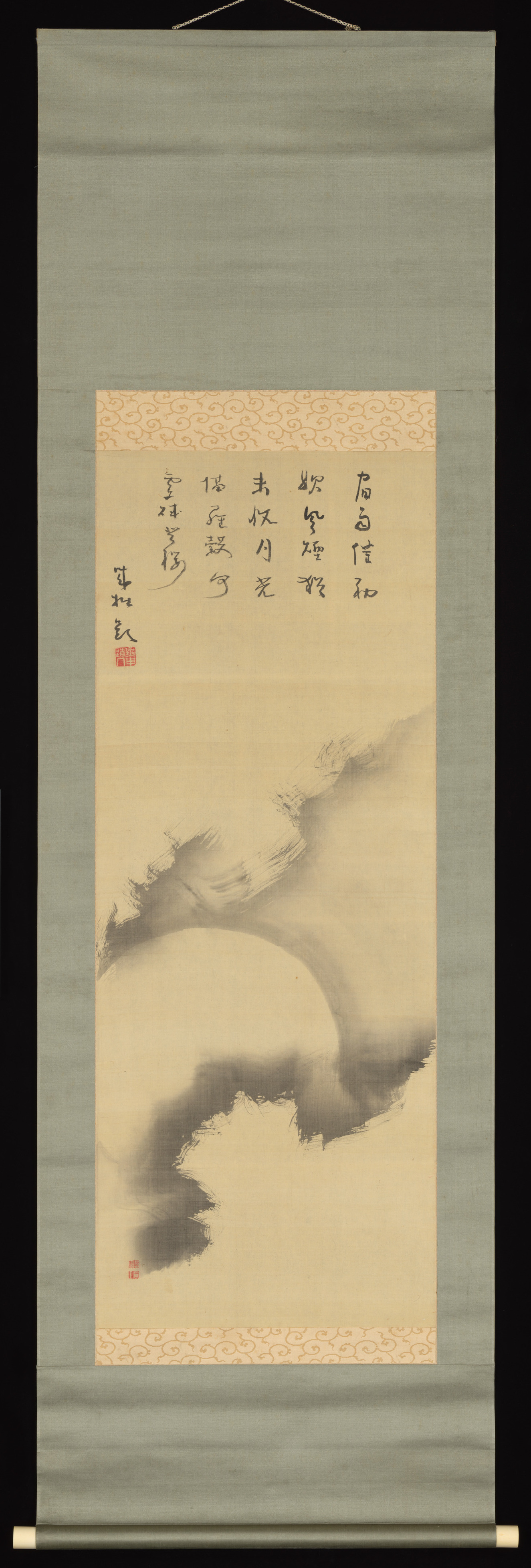Moon amid Clouds
Inscription by Seisetsu Shūcho Japanese
Painting by Gekijō Japanese
Not on view
A gibbous moon, rendered in reserve, shines through a bank of ink-wash clouds, which seem to gnaw at the edges of the lunar orb—almost abstract in conception. The painting, profoundly Zen in its minimalism and mysterious expressiveness, is unsigned so the only clue we have about the identity of who brushed it is the double-seal reading “Gekijō” 撃壤. Here the phrase on the seal derives from the four-character saying Kofuku gekijō 鼓腹撃壌, meaning, literally, “to pat one’s belly and stamp the ground,” which is a roundabout way of expressing the blissful feeling of “everything in the world is at peace.”
We have yet to identify the artist who used this seal, though during the time the Rinzai monk-calligrapher Seisetsu Shūcho was active there was a Nanga artist named Ōta Gekijōshi, who lived in Komatsushima on Shikoku island, coincidentally, perhaps, not far from where Seisetsu was born. Though at this point it remains complete speculation whether this seal might have been used by Gekijōshi, it seems too much of a coincidence that his patron, student and confidante later in his life was a scholar-monk named Kankanshi 閑々子 (1752–1827), who had trained at a Zen temple Seisetsu was also affiliated with early in his life. Kankanshi at the end of his career retired to Komatsushima where he took painting lessons from Gekijōshi. So there is a possibility Kankanshi had requested the painting from his teacher and the calligraphy from the famous Zen-monk calligrapher—but this hypothesis requires further investigation.
In the eccentric calligraphy by Seisetsu, the shape of the characters comes across as intentionally deformed, breaking rules of handwriting, and almost whimsical in appearance. The silhouettes of the characters are deliberately exaggerated, resonating with the abstract and mysterious ink painting below. The poem evokes imagery of somemisty moonlit night, keeping in mind the moon serves as a metaphor of enlightenment in Zen writings. The character for “wind” 風, second character of the second column from the right draws the eye immediately because of its darker ink tone, and in turn resonates semantically with the image of clouds moving in the evening sky. The characters comprising the monk-calligrapher’s signature, “Inscribed by Seisetsu,” to the lower left of the inscription proper are also highly idiosyncratic, and accompanied by a seal that expresses the spiritual goal of a monk-artist who has dedicated himself to a life of Zen reclusion as opposed to the pursuit of worldly comforts: “Escape into uselessness” (Muyō tonnyū 無用遁入). Perhaps in a nod to his self-deprecating art name, nearly a century later the Taishō Emperor bestowed upon the scholar-monk the posthumous honorary title of Daiyū Kokushi 大用国師, the National Master of Great Usefulness.
The poem can be deciphered and tentatively translated as follows:
宿雨催初夜
風煙猶未収
月光隔羅穀
何處誠登楼
At the inn rainy weather
hastens evening’s arrival.
Wind and haze
have yet to engulf
The moonlight,
filtered through the curtains.
Where then can we climb
the tower to behold this view?
(Trans. John T. Carpenter)
Seisetsu, originally from Shikoku, was ordained at the age of seven, and became a wandering monk in his teens. He trained with the charismatic Zen master Gessen Zenne (1701–1781) for a while, and was invited to Engakuji in Kamakura, and consequently switched his affiliation from the Myōshinji to the Engakuji subsect of Rinzai. He remained the abbot there for twenty-eight years, restoring it to greatness as a training temple. Seisetsu eventually had hundreds of disciples, and several of his Dharma-heirs attained influential positions in the Zen hierarchy. At Engakuji, Sengai Gibon (1750–1837), even more famous for his idiosyncratic calligraphy and sketch paintings, was among the trainees. Later, Seisetsu moved to Shōkokuji in Kyoto. A scholar- monk with a wide cultural network—including the daimyo tea master Matsudaira Fumai and the poet Kagawa Kageki—Seisetsu was accomplished as a poet, calligrapher and painter.
This image cannot be enlarged, viewed at full screen, or downloaded.
This artwork is meant to be viewed from right to left. Scroll left to view more.



